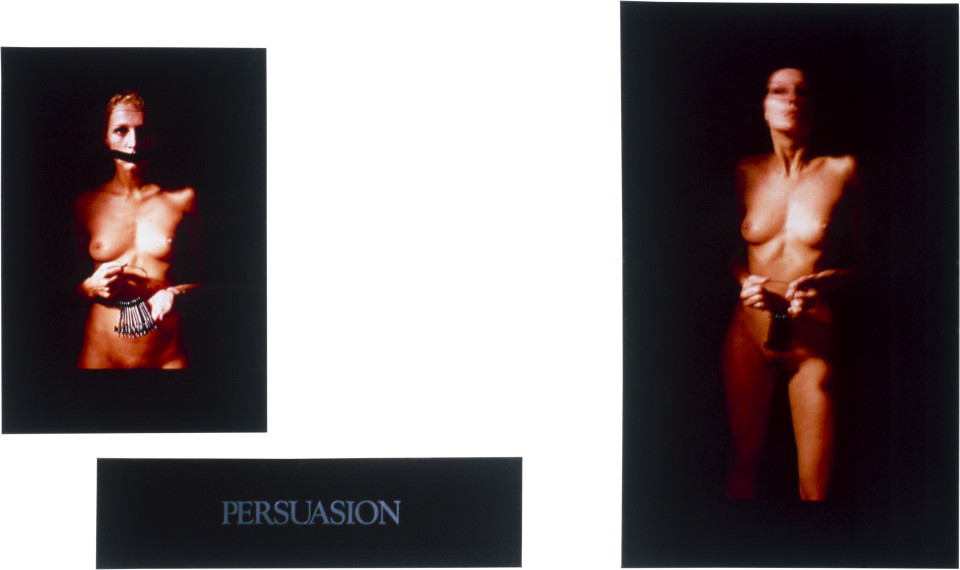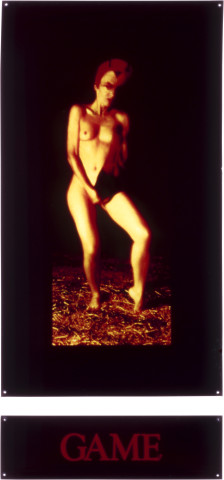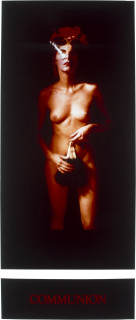Christine Webster's second solo exhibition at Roslyn Oxley9 Gallery.
Exhibition Dates: 21 November – 9 December 1989
One feature of postmodern culture is the insistent feminist voice. In the visual arts it may be the photograph that reveals this force most potently. The rhetoric of realism that photographs once purported to deal with operated within the rules of a dominant ideology. Woman was placed in a passive rather than active role, as object rather than subject and was much the product of masculine appropriation. Photographers within a feminist politic are now devising ways to contest this tradition.
Introducing her work in New Zealand during the early '80s, Christine Webster cut across the grain of the prevailing documentary genre with highly orchestrated tableaux. Models in her large cibachromes intentionally avoided any clear gender identification, as though enacting a process of psychoanalysis, conveying the spectator into the realms of symbol and myth.
Because Webster recognised that there is no experience unmediated by language, in 1987 she began to incorporate words with her photographs. The text Moon Envy, for instance, is printed on a strip of glossy black paper beneath the arched body of a male nude poised as though airborne. Alluding in part to man's craving for the hidden forces of woman, it is also a witty riposte to Freud.
Increasingly the artist uses herself as a protagonist in these dramas of the unconscious. With the diptych Game and Bird, she was model for both, playing on the association of bird with woman - a soft, fluttering entity - and the more sharply focused; aggressively masculine presence of the bird of prey or the game.
Our mass media provides ample evidence of the controlling of feminine sexuality and its representation. In questioning this process, Webster produces comparable spectacles, skillfully borrowing tricks from admen and fashion photographers. Her figures (close to human scale) are multi-referenced symbols dramatically lit against impenetrable shadow. The spec-tacular brilliance of high-gloss photographic surfaces have become the substitute for the fascination of the mirror.
For this artist, woman constructs her own identity. Arrested in her role as object of desire, this persona is reflected upon and attacked. The feminine body, as depicted by Webster, is never neutral, never natural, but centrally present and figured with language. A 1988 work, Persuasion, juxtaposes two cibachromes; the first a female nude proferring a ring of keys (to secret, locked chambers), her mouth gagged. The woman is a potent symbol of masculine specularity, a passive conveyor of mysteries, but denied a voice. On the right, the opposite; here woman is assertive and in full control of the attributes of her gender.
This year Christine Webster produced a series of photographs addressing the devastating effects of oppression, especially under milit-ary dictatorship. She spent several months in Hong Kong, keenly feeling the repercussions of the China crisis after the pro-democracy student movement was crushed. Turning to black-and-white photography she denied movement in her subjects for the first time. Here the thin figure is sharply focused and uncompromisingly lit as an expressive symbol of protest.
Still using large formats, with text on plaques below, these new images are stark and confrontational. Rupture, for instance, features a male nude with a breathing, mask over his nose and mouth and another covering his genitals. He is protected, but at the same time, obstructed and rendered impotent. Another, Bite Out, features Webster again as a performer in a complex game of masquerade. Here woman is cocooned in cotton wool, denied sight and insulated from reality. She is disturbingly corpse-like.
Questions of authoritarianism versus individual freedom, of human frailty and capacity for cruelty, of barbarism and enlightenment inform these recent works. As always with this talented artist, what is at issue is a critique of dominant and repressive ideologies that beset our civilisation.
Anne Kirker,
Curator of prints, drawings ard photographs,
Queensland Art Gallery, Brisbane, Australia.
August 1989











